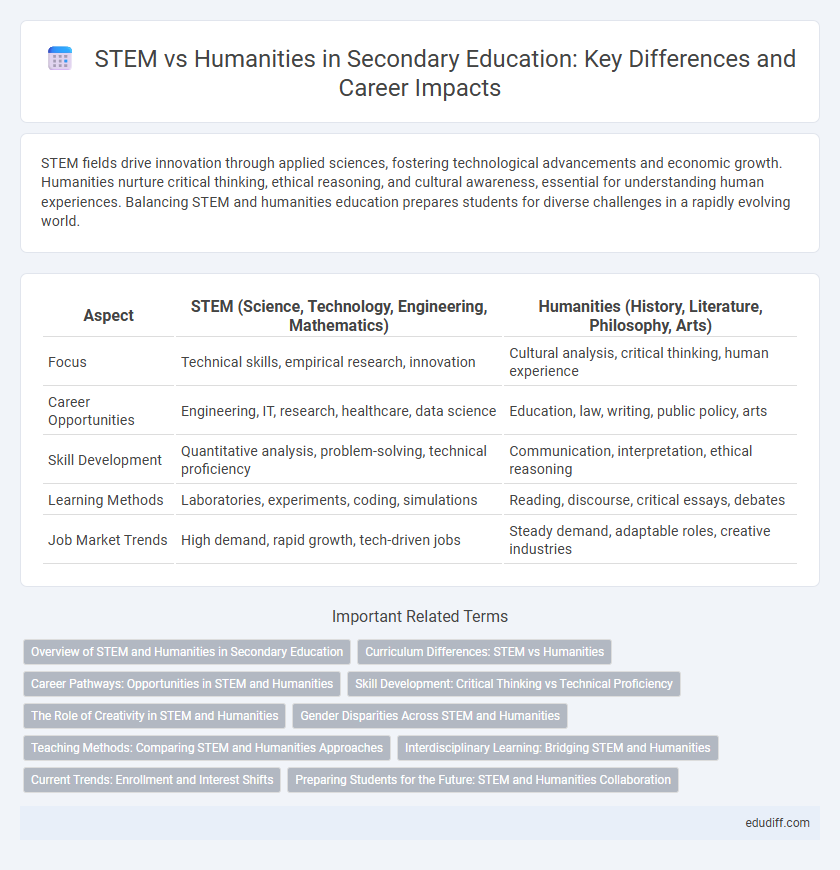STEM fields drive innovation through applied sciences, fostering technological advancements and economic growth. Humanities nurture critical thinking, ethical reasoning, and cultural awareness, essential for understanding human experiences. Balancing STEM and humanities education prepares students for diverse challenges in a rapidly evolving world.
Table of Comparison
| Aspect | STEM (Science, Technology, Engineering, Mathematics) | Humanities (History, Literature, Philosophy, Arts) |
|---|---|---|
| Focus | Technical skills, empirical research, innovation | Cultural analysis, critical thinking, human experience |
| Career Opportunities | Engineering, IT, research, healthcare, data science | Education, law, writing, public policy, arts |
| Skill Development | Quantitative analysis, problem-solving, technical proficiency | Communication, interpretation, ethical reasoning |
| Learning Methods | Laboratories, experiments, coding, simulations | Reading, discourse, critical essays, debates |
| Job Market Trends | High demand, rapid growth, tech-driven jobs | Steady demand, adaptable roles, creative industries |
Overview of STEM and Humanities in Secondary Education
Secondary education emphasizes STEM subjects--science, technology, engineering, and mathematics--due to their critical role in fostering analytical thinking and problem-solving skills. Humanities courses, including literature, history, and philosophy, develop critical reasoning, cultural awareness, and communication abilities essential for holistic education. Balancing STEM and humanities in secondary curricula prepares students for diverse academic and career pathways by integrating technical proficiency with ethical and social understanding.
Curriculum Differences: STEM vs Humanities
STEM curricula emphasize mathematics, science, technology, and engineering, focusing on problem-solving, analytical skills, and practical applications. Humanities curricula prioritize literature, history, philosophy, and the arts, fostering critical thinking, cultural awareness, and interpretive skills. The instructional methods in STEM are often experimental and data-driven, whereas humanities rely on textual analysis and theoretical frameworks.
Career Pathways: Opportunities in STEM and Humanities
STEM career pathways offer high demand roles in technology, engineering, healthcare, and data science, often leading to higher starting salaries and job growth rates according to the U.S. Bureau of Labor Statistics. Humanities career pathways provide opportunities in education, social sciences, communication, and the arts, fostering critical thinking, creativity, and cultural awareness vital for professions in public service, media, and human resources. Both fields develop transferable skills, but STEM careers tend to align with rapid technological advancements, while humanities paths emphasize ethical reasoning and interpersonal communication.
Skill Development: Critical Thinking vs Technical Proficiency
STEM education emphasizes technical proficiency through hands-on learning in fields like engineering, computer science, and mathematics, fostering problem-solving skills directly applicable to technology-driven industries. Humanities programs prioritize critical thinking by analyzing literature, history, and philosophy, enhancing skills in interpretation, ethical reasoning, and argumentative writing. Both domains contribute uniquely to skill development, with STEM advancing quantitative and analytical abilities while humanities cultivate qualitative analysis and creativity.
The Role of Creativity in STEM and Humanities
Creativity drives innovation in both STEM and humanities by enabling problem-solving and the generation of novel ideas. In STEM, creativity facilitates technological advancements and scientific discoveries through experimental design and interdisciplinary thinking. Humanities leverage creativity to interpret complex human experiences and foster critical thinking, enriching cultural understanding and communication.
Gender Disparities Across STEM and Humanities
Gender disparities in secondary education reveal significant differences in STEM and humanities enrollment, with female students underrepresented in STEM fields such as mathematics, physics, and engineering. Research shows that societal stereotypes, lack of female role models, and gender-biased teaching practices contribute to lower female participation and achievement in STEM compared to humanities subjects like literature and history. Efforts to close this gap include targeted mentoring programs, inclusive curricula, and policies aimed at encouraging girls to pursue STEM careers while maintaining strong female presence in humanities.
Teaching Methods: Comparing STEM and Humanities Approaches
STEM teaching methods emphasize hands-on experiments, problem-solving, and application-based learning to foster critical thinking and technical skills. Humanities instruction prioritizes interpretative analysis, critical discussion, and reflective writing to develop communication and ethical reasoning abilities. Both approaches tailor instructional strategies to cultivate discipline-specific competencies and cognitive development.
Interdisciplinary Learning: Bridging STEM and Humanities
Interdisciplinary learning in secondary education integrates STEM subjects with the humanities to enhance critical thinking and creativity. Combining data analysis, scientific inquiry, and technical skills from STEM with ethical reasoning, cultural context, and communication from the humanities fosters well-rounded problem-solving abilities. This approach prepares students for complex real-world challenges by encouraging collaboration across disciplines like engineering, philosophy, literature, and social sciences.
Current Trends: Enrollment and Interest Shifts
Recent data reveals a significant rise in STEM enrollment, fueled by increased demand for skills in technology, engineering, and data science fields. Humanities programs, however, face declining interest, attributed to perceived limited career prospects and funding cuts in educational institutions. This shift reflects broader economic trends emphasizing innovation and technical expertise in the global job market.
Preparing Students for the Future: STEM and Humanities Collaboration
Integrating STEM and humanities education equips students with critical problem-solving skills and ethical reasoning, essential for addressing complex global challenges. Collaborative curricula foster creativity, communication, and analytical thinking by combining technological innovation with humanistic perspectives. This interdisciplinary approach prepares students to adapt and thrive in diverse, evolving professional landscapes.
STEM vs Humanities Infographic

 edudiff.com
edudiff.com